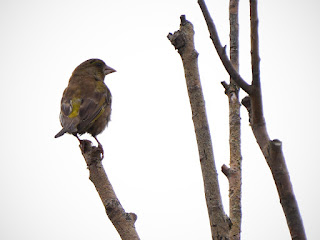A morning visit to the Round Pond didn't turn up a Little Owl, and I feared I had seen the last of them. But when I came back later there was the young one looking down from a disused squirrel drey.
Yesterday Des McKenzie reported a Firecrest in a Lucombe Oak in the Flower Walk. I had no idea what a Lucombe Oak was and had to look it up. It's a cross between a Cork Oak and a Turkey Oak, and is the tree that I have described already here as a Cork Oak. I went there and could hear a faint high-pitched peeping, and there was something very small flitting around in the back of a yew on the opposite side of the path. But I'm far from sure what it was.
Otherwise I saw no small birds in the Flower Walk apart from the usual Great Tits that turn up to collect pine nuts.
A Robin deep in the shadows of a yew in the leaf yard struck a grand pose.
A Greenfinch twittered in a dead tree near the Rudolf Steiner memorial bench.
Three Magpies looked for insects in the rotten wood of a fallen tree trunk.
A Wood Pigeon drank from the little stream in the Dell. Pigeons are the only birds that can drink continuously, while other birds take a beakful and throw their head back to swallow it. I think pigeons can manipulate their tongue to make a kind of drinking straw.
One of the young Grey Herons stood on a post at the island with its crest up, looking rather silly.
A Black-Headed Gull took a strong line over the ownership of a Ritz cracker it had found.
The pigeon-eating Lesser Black-Backed Gull was in his favourite place on the Dell restaurant roof, flying down from time to time to chase Herring Gulls off his territory.
This young Lesser Black-Back wasn't chased away. Perhaps it's his offspring.
It was briefly next to a young Herring Gull, showing how hard it is to tell the two species apart at that age. It's on the right.
Soon afterwards the Herring Gull was routed by the pigeon eater and flew off, displaying the pale inner primaries that are the only reliable was to distinguish a young Herring Gull from a young Lesser Black-Back. The latter have all dark primaries and secondaries, so that the trailing edge of the wing is all the same colour.
A gull -- I think a young Lesser Black-Back -- hitched a ride on a pedalo. In this way it could tour the lake looking for something to scavenge without taking the trouble to fly.
The usual Moorhen stood on the weir at the Serpentine outflow. I don't think their nest here can have succeeded as I have seen no chicks -- but with secretive Moorhens you can't be sure.
Three Gadwalls on the Long Water -- two drakes and a female, were cruising side by side.
They suddenly decided to take off.
Three Mute Swans preened together on the island without trying to murder each other. They must be family.






%20on%20roof%202022%202a.jpg)






Oh my God, this is Finding Nemo's glorious "Mine mine mine" sketch come to life!
ReplyDeleteI repeat, Swans are way more civilised than we are.
Tinúviel
Yes, the people at Pixar got the gulls exactly right. I suppose if you are an animator trying to portray realistic action it makes you a very acute observer. Their flight was perfect. And I'm sure you've seen the Pixar short film Piper which, for all its sentimentality, got sandpipers to a T.
DeleteThat's one of my favourite animation films ever. Whoever made it loved Sandpipers with a passion.
Delete